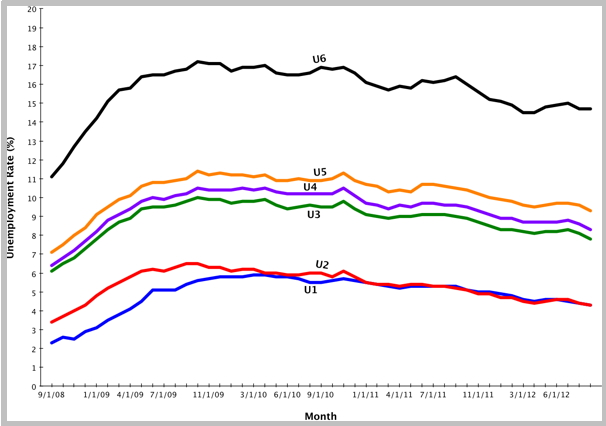Some of the birther Jack Welch data challenged folks have been raising the issue of U6 being unchanged versus U3’s 0.3% drop as more “proof” of our national innumeracy cooked books.
First off, there are few people who have been advocating the reportage of U6 longer than I have — See e.g., this 2008 post: Unemployment Reporting: A Modest Proposal (U3 + U6; (you emailers/commenters who think I need to be “clued into U6,” may I suggest you try that Google search box at the top right? Thanks)
Second, those of you who are interested in the more wonky aspects of Labor data need to understand the differences between what these various under-utilization metrics are actually measuring.
According to the Bureau of Labor Statistics:
BLS, U1-U6
U-1 Persons unemployed 15 weeks or longer, as a percent of the civilian labor force
U-2 Job losers and persons who completed temporary jobs, as a percent of the civilian labor force
U-3 Total unemployed, as a percent of the civilian labor force (official unemployment rate)
U-4 Total unemployed plus discouraged workers, as a percent of the civilian labor force plus discouraged workers
U-5 Total unemployed, plus discouraged workers, plus all other persons marginally attached to the labor force, as a percent of the civilian labor force plus all persons marginally attached to the labor force
U-6 Total unemployed, plus all persons marginally attached to the labor force, plus total employed part time for economic reasons, as a percent of the civilian labor force plus all persons marginally attached to the labor force
Those definitions are straight from the BLS site. Become familiar with these definitions, and you it will become clear that they measure different things.
Now that you understand what these different alternative measures of labor underutilization actually measure, lets see what they look like side by side; the Wonkblog has the perfect chart:

Source: Washington Post
As you can see, they move together, but not quite in lockstep. Some of them are more volatile than others. But overall, they seem to move more or less in the same direction.


What's been said:
Discussions found on the web: